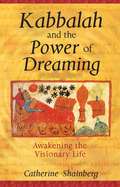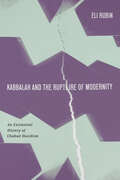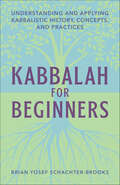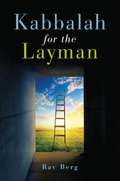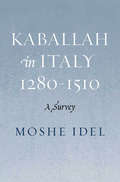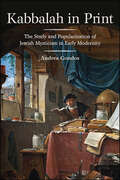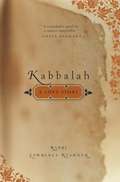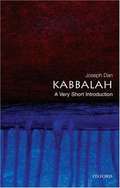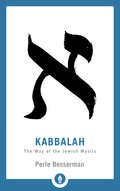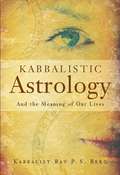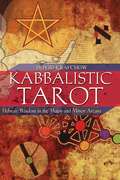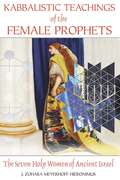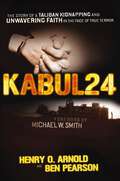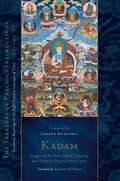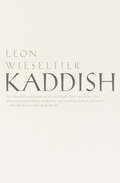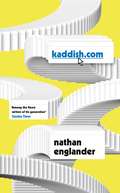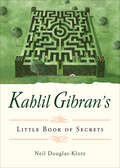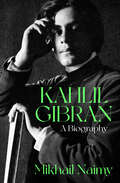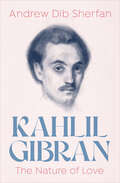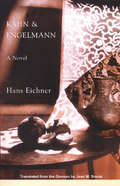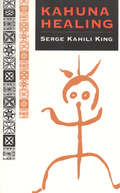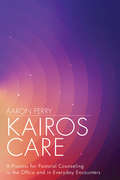- Table View
- List View
Kabbalah and the Power of Dreaming: Awakening the Visionary Life
by Catherine ShainbergA dynamic exposition of the powerful, ancient Sephardic tradition of dreaming passed down from the renowned 13th-century kabbalist Isaac the Blind• Includes exercises and practices to access the dream state at will in order to engage with life in a state of enhanced awareness • Written by the close student of revered kabbalist Colette Aboulker-Muscat In Kabbalah and the Power of Dreaming Catherine Shainberg unveils the esoteric practices that allow us to unlock the dreaming mind's transformative and intuitive powers. These are the practices used by ancient prophets, seers, and sages to control dreams and visions. Shainberg draws upon the ancient Sephardic Kabbalah tradition, as well as illustrative stories and myths from around the Mediterranean, to teach readers how to harness the intuitive power of their dreaming. While the Hebrew Bible and our Western esoteric tradition give us ample evidence of dream teachings, rarely has the path to becoming a conscious dreamer been articulated. Shainberg shows that dreaming is not something that merely takes place while sleeping--we are dreaming at every moment. By teaching the conscious mind to be awake in our sleeping dreams and the dreaming mind to be manifest in daytime awareness, we are able to achieve revolutionary consciousness. Her inner-vision exercises initiate creative and transformative images that generate the pathways to self-realization.
Kabbalah and the Rupture of Modernity: An Existential History of Chabad Hasidism (Stanford Studies in Jewish Mysticism)
by Eli RubinKabbalah and the Rupture of Modernity provides a comprehensive intellectual and institutional history of Chabad Hasidism through the Kabbalistic concept of ṣimṣum. The onset of modernity, Eli Rubin argues, was heralded by this startling idea: existence itself is predicated on a self-inflicted "rupture" in the infinite assertion of divinity. Centuries of theoretical disputations concerning ṣimṣum ultimately morphed into religious and social schism. These debates confronted the meaning of being and forged the animating ethos of Chabad, the most dynamic movement in modern Judaism. Chabad's distinctive character and self-image, Rubin shows, emerged from its spirited defense of Hasidism's interpretation of ṣimṣum as an act of love leading to rapturous reunion. This interpretation ignited a literal conflagration, complete with book burnings, denunciations, investigations, and arrests. Chabad's subsequent preoccupation with ṣimṣum was equally significant for questions of legitimacy, authority, and succession, as for existential questions of being and meaning. Unfolding the story of Chabad from the early modern period to the twentieth century, this book provides fresh portraits of the successive leaders of the movement. Innovatively integrating history, philosophy, and literature, Rubin shows how Kabbalistic ideas are crucially entangled in the experience of modernity and in the response to its ruptures.
Kabbalah for Beginners: Understanding and Applying Kabbalistic History, Concepts, and Practices
by Brian Yosef Schachter-BrooksGain a better understanding of the Kabbalah path to spiritual transformation and a deeper connection with the Jewish faithComing from the Hebrew root that means "to receive," Kabbalah is known as the "inner" or "esoteric" dimension of Judaism. Kabbalah for Beginners is your introduction to a great spiritual tradition that will help you deepen your experience of the Divine through Kabbalistic portals into the Eternal Present.Divided into four categories: theosophical, ecstatic, Hasidic, and contemporary, this book explores everything including ancient concepts, core teachings, practices and traditions, and even misconceptions of Kabbalah. Written in a contemporary tone and point of view, this beginner's guide brings this ancient discipline into the here and now.In Kabbalah for Beginners you'll find:God is existence—The Kabbalist method is that God is not a being, not even the most supreme being, but is rather Being itself.What is Kabbalah—Get inspired by interspersed quotes from the Torah and frequent sidebars that highlight the Kabbalah's relevance to readers' experiences.Spirituality simplified—Learn through a clear straightforward language to bring intuitiveness to deep philosophical concepts.Discover a contemporary guide to this ancient wisdom and move toward spiritual transformation.
Kabbalah for the Layman
by Rav BergPrior to the popularization of Kabbalah, Kabbalist Rav Berg synthesized the wisdom's key concepts into a progressive system, rather than the non-linear manner of exploration previously available. This book is the result. The kabbalistic lineage is inextricably tied to the study of the knowledge itself. To this end, Rav Berg includes historical milestones, as well as insights about master kabbalists whose lives and deaths provide a basis for learning and connection. Kabbalah for the Layman is a profound study of deep kabbalistic concepts made applicable to daily life in the 21 century. At the time of its first printing in 1981, this title was considered a revolutionary portal to expanded consciousness, Kabbalah for the Layman Volumes 1,2, and 3 became classics. Newly edited, this book contains the all three volumes for a comprehensive introduction to Kabbalah.
Kabbalah in Italy 1280-1510
by Moshe IdelThis sweeping survey of the history of Kabbalah in Italy represents a major contribution from one of the world's foremost Kabbalah scholars. The first to focus attention on a specific center of Kabbalah, Moshe Idel charts the ways that Kabbalistic thought and literature developed in Italy and how its unique geographical situation facilitated the arrival of both Spanish and Byzantine Kabbalah. Idel analyzes the work of three major Kabbalists--Abraham Abulafia, Menahem Recanati, and Yohanan Alemanno--who represent diverse schools of thought: the ecstatic, the theosophical-theurgical, and the astromagical. Directing special attention to the interactions and tensions among these forms of Jewish Kabbalah and the nascent Christian Kabbalah, Idel brings to light the rich history of Kabbalah in Italy and the powerful influence of this important center on the emergence of Christian Kabbalah and European occultism in general.
Kabbalah in Print: The Study and Popularization of Jewish Mysticism in Early Modernity
by Andrea GondosHow did Jewish mysticism go from arcane knowledge to popular spirituality? Kabbalah in Print examines the cultural impact of printing on the popularization, circulation, and transmission of Kabbalah in the late sixteenth and early seventeenth centuries. The Zohar, in particular, generated a large secondary literature of study guides and reference works that aimed to ease the linguistic and conceptual challenges of the text. The arrival of printed classics of Kabbalah was soon followed by the appearance of new literary genres—anthologies, digests, lexicons, and other learning aids—that mediated mystical primary sources to a community of readers not versed in this lore. A detailed investigation of the four works by R. Yissakhar Baer (ca.1580–ca.1629) of Prague sheds light on the literary strategies, pedagogic concerns, and religious motivations of secondary elites, a new cadre of authors empowered by the opportunities that printing opened up. Andrea Gondos highlights shifting intellectual and cultural boundaries in the early modern period, when the transmission of Kabbalah became a meeting point connecting various strata of Jewish society as well as Jewish and Christian intellectuals.
Kabbalah: A Love Story
by Lawrence KushnerSometime, somewhere, someone is searching for answers... in a thirteenth-century castle... on a train to a concentration camp... in a New York city apartment. Hidden within the binding of an ancient text that has been passed down through the ages lies the answer to one of the heart's eternal questions. When the text falls into the hands of Rabbi Kalman Stern, he has no idea that his lonely life of intellectual pursuits is about to change once he opens the book. Soon afterward, he meets astronomer Isabel Benveniste, a woman of science who stirs his soul as no woman has for many years. But Kalman has much to learn before he can unlock his heart and let true love into his life. The key lies in the mysterious document he finds inside the Zohar, the master text of the Kabbalah.
Kabbalah: A Very Short Introduction
by Joseph DanIn Kabbalah: A Very Short Introduction, Joseph Dan, one of the world's leading authorities on Jewish mysticism, offers a concise and highly accurate look at the history and character of the various systems developed by the adherents of the Kabbalah. Dan sheds light on the many misconceptions about what Kabbalah is and isn't--including its connections to magic, astronomy, alchemy, and numerology--and he illuminates the relationship between Kaballah and Christianity on the one hand and New Age religion on the other. The book provides fascinating historical background, ranging from the mystical groups that flourished in ancient Judaism in the East, and the medieval schools of Kabbalah in Northern Spain and Southern France, to the widening growth of Kabbalah through the school of Isaac Luria of Safed in the sixteenth century, to the most potent and influential modern Jewish religious movement, Hasidism, and its use of kabbalistic language in its preaching. The book examines the key ancient texts of this tradition, including the Sefer Yezira or "Book of Creation," The Book of Bahir, and the Zohar. Dan explains Midrash, the classical Jewish exegesis of scriptures, which assumes an infinity of meanings for every biblical verse, and he concludes with a brief survey of scholarship in the field and a list of books for further reading. Embraced by celebrities and integrated in many contemporary spiritual phenomena, Kabbalah has reaped a wealth of attention in the press. But many critics argue that the form of Kabbalah practiced in Hollywood is more New Age pabulum than authentic tradition. Can there be a positive role for the Kabbalah in the contemporary quest for spirituality? In Kabbalah, Joseph Dan debunks the myths surrounding modern Kabbalistic practice, offering an engaging and dependable account of this traditional Jewish religious phenomenon and its impact outside of Judaism.
Kabbalah: The Way of The Jewish Mystic
by Perle Epstein Edward HoffmanThis pioneering, popular introduction to Jewish mysticism was the first survey written for a general audience, and it's now available in Shambhala Classics. Epstein presents the methods, schools, and legendary practitioners of Kabbalah, unraveling the web of ancient traditions hidden in such texts as the Sefer Yetzirah and the Zohar. The words of the great Kabbalists appear throughout the book, giving instructions on practices such as contemplation of the Bible's secret teachings, ecstatic prayer, and intensive meditation.
Kabbalistic Astrology
by Rav P. BergAncient Kabbalistic mysticism and the search for meaning by looking to the stars are related in ways that may surprise readers. Kabbalah, in fact, offers arguably the oldest and wisest application of astronomy and astrology known to humankind. Kabbalistic Astrology is a tool for understanding one's individual nature at its deepest level and putting that knowledge to immediate use in the real world. A natural addition to Berg's many writings on spirituality, the book explains why destiny is not the same as predestination and shows that we have many possible futures and can become masters of our fate. Written in Berg's trademark clear, intelligible style, the book teaches how to discover challenges faced in previous incarnations and how to overcome them, as well as the secrets to finding the love, success, and spiritual fulfillment.
Kabbalistic Tarot: Hebraic Wisdom in the Major and Minor Arcana
by Dovid KrafchowAn introduction to the ancient kabbalistic origins and meanings of the tarot • Reveals the intimate relationship of the tarot to the esoteric teachings of the Torah and the Kabbalah• Provides kabbalistic interpretations for all 78 traditional tarot cards• Includes a detailed kabbalistic reading and interpretation of the Tree of Life spreadWhen the Greeks invaded Israel and forbade study of the Torah, the Jewish people began a secret method of Toranic study that appeared to be merely a simple way to fill time: playing cards. These first tarot decks enabled study of the Torah without detection. Once the Maccabees expelled the Greeks from Israel and Israel once again became a Jewish kingdom, tarot cards dropped from sight. Fifteen hundred years later, in response to Jewish disputations with Catholic theologians, political and religious persecutions, and ultimately the Inquisition, the cards resurfaced as a secret learning tool of the Torah.In Kabbalistic Tarot, Dovid Krafchow details how the true meaning of the tarot is locked within the Kabbalah. He shows the correspondence between the 22 Major Arcana cards and the 22 letters of the Hebrew alphabet and how the four suits correspond to the four kabbalistic worlds of Briah, Yitzerah, Asiyah, and Atzilut. He describes the kabbalistic meanings of each of the 78 cards and their relations to the Torah and provides insight into the Tree of Life spread through several kabbalistic readings.
Kabbalistic Teachings of the Female Prophets: The Seven Holy Women of Ancient Israel
by J. Zohara HieronimusThe spiritual teachings of Israel’s biblical prophetesses from a kabbalistic perspective • Explores the lives and symbolic significance of seven female prophets: Sarah, Miriam, Devorah, Chanah, Avigail, Chuldah, and Esther • Uses the gematria of Jewish metaphysics to demonstrate that prophecy is a mystical initiatory path by which Divine Will is made known, not only a tool for telling the future • Presents practical applications of kabbalistic teachings for spiritual development The seven prophetesses of Israel--Sarah, Miriam, Devorah, Chanah, Avigail, Chuldah, and Esther--lived between 1800 and 350 BCE. Their combined lives reflect a kabbalistic path of spiritual evolution that is as pertinent to our lives today as it was for the biblical communities in which they lived.From her studies of the Torah and classical gematria, Zohara Hieronimus shows that each prophetess is linked to a Sefirah on the kabbalistic Tree of Life: from creation (Sarah) through learning correct moral action (Devorah) to the promise of redemption and ultimately resurrection (Esther). Using the stories of their lives and teachings, Hieronimus reveals the relationship of each prophetess to the seven days of the week, the seven sacred species of Israel, the human body, and Jewish holidays and rituals.This book presents the kabbalistic teachings of these holy women and what they reveal about the initiatory path of individual development and redemption. The seven prophetesses show that every person has a part to play in the repair of the world, and Hieronimus gives a practical set of maps and spiritual guidelines for that journey.
Kabul 24: The Story of a Taliban Kidnapping and Unwavering Faith in the Face of True Terror
by Ben PearsonYou can't kidnap someone's hope.They were teachers, engineers, nurses, students, and artists from around the world who answered God's call to help Afghan refugees rebuild their lives following decades of war. But as international tensions reached inferno levels in 2001, extremists set out to rid Afghanistan of anyone who posed a threat to Islam and the influence of the Taliban.The Shelter Now International (SNI) humanitarian effort led by Christians from Western countries topped the Taliban's list.Kabul 24 is the story you didn't see on CNN. It's the story of the human heartbeats behind the headlines that captivated the world during one of the most volatile political windows in rencent history. Relive the harrowing, true account of how eight humanitarian aid workers imprisoned behind enemy lines would survive and even thrive in the midst of betrayal, inhumane conditions, and the massive Allied bombing raids?conducted by their own countries?following the terrorist attacks of 9/11.From peacemakers to pawns in a story of political and religious turmoil, the eight would individually and collectively discover a level of hope that would free them from captivity long before their dramatic rescue by American Special Forces 105 days after their abduction.
Kadam: Essential Teachings of the Eight Practice Lineages of Tibet, Volume 3 (The Treasury of Precious Instructions)
by Jamgon Kongtrul Lodro TayeA comprehensive selection of texts central to the Kadam lineage of Tibetan Buddhism, including topics like Mind Training, Stages of the Path, and esoteric tantric instructions.The Treasury of Precious Instructions by Jamgön Kongtrul Lodrö Taye, one of Tibet&’s greatest Buddhist masters, is a shining jewel of Tibetan literature, presenting essential teachings from the entire spectrum of practice lineages that existed in Tibet. In its eighteen volumes, Kongtrul brings together some of the most important texts on key topics of Buddhist thought and practice as well as authoring significant new sections of his own. The Kadam lineage derives from the teachings and practices taught by the Indian master Atiśa and his Tibetan students. Atiśa spent twelve years in Tibet and left a scholarly and devotional lineage that would be significant to all traditions of Tibetan Buddhism, but particularly the Geluk, the tradition of the Dalai Lamas, which fashioned themselves as the New Kadam tradition. Jamgön Kongtrul&’s catalog to The Treasury of Precious Instructions classifies Kadam literature into five categories: treatise, instruction, esoteric practice, ancillary works, and associated works. The first two are the main topics covered in this volume: Lamrim, or Stages of the Path, and Lojong, or Mind Training. These two Kadam teachings continue to exert a significant influence on Tibetan Buddhism and therefore represent the legacy of the Kadam tradition. The first centers around &“The Lamp for the Path to Enlightenment,&” written by the eleventh-century Indian master Atiśa who spent twelve years in Tibet, and this volume also includes stories of Atiśa&’s life and travels. The second set of teachings consists of aphorisms known as the Seven-Point Mind Training, meant to be used as contemplative practices to develop compassion and transform the mind. These selections show not only the foundational texts of the Kadam tradition but also the widespread impact these teachings continued to have across traditions.
Kaddish
by Leon WieseltierEverything struck hard. The door slamming behind me in the black car. The shovel stabbing the mound of soil. The wooden box hitting the floor of the pit. I stood and I swayed and I said what I was told to say. I was presented with the words that justify the judgment, and I justified the judgment. "He is the Rock, His work is perfect, for all His ways are judgment . . . " I was presented with the words of the kaddish, the long one for the funeral, the one about the world that will be made new, the one that I had never said before, and I uttered it. "Magnified and sanctified may His great Name be . . . " "Magnified and sanctified . . . " Sounds, not words. Words that were nothing but sounds. The words spilled into the pit and smashed upon my father's coffin. I watched the words disperse across the surface of the wood like the clods of dirt that were falling upon it. I saw them there, the shattering words. I saw the letters and their shades. Finally they vanished into the earth. They were buried with him. Justify the judgment, but judge the judgment, too. Bring the judgment to judgment!Out of tears, thoughts. So begins this extraordinary spiritual journal--a record of the inner life of one of America's most brilliant intellectuals during a year of mourning. When Leon Wieseltier's father died in March 1996, he began to observe the rituals of the traditional year of mourning, going daily to the synagogue to recite the kaddish. Be-tween his prayers and his everyday responsibilities, he sought out ancient, medieval, and modern Jewish texts in pursuit of the kaddish's history and meaning. And every day he studied, translated, and wrote his own reflections on the obscure texts that he found, punctuating his journal with stories about life in his synagogue and about his family's progress through grief. In reflecting upon the fate of his father and of his people, he wrestles with problems of loss and faith, the meaning of tradition, freedom and determinism, and the perplexity of rational religion. Kaddish is a work of history, philosophy, and interior autobiography, of moral force and emotional power.
Kaddish
by Leon WieseltierWinner of the 1998 National Jewish Book Award"An astonishing fusion of learning and psychic intensity; its poignance and lucidity should be an authentic benefit to readers, Jewish and gentile." --The New York Times Book ReviewChildren have obligations to their parents: the Talmud says "one must honor him in life and one must honor him in death." Leon Wieseltier, a diligent but doubting son, recites the Jewish prayer of mourning at his father's grave, and then embarks on the traditional year of saying the kaddish daily.Wieseltier's highly acclaimed Kaddish is the spiritual and thoughtful journal of one of America's most brilliant intellectuals. Driven to explore th origins of the kaddish, from the ancient legend of a wayeard ghost to a 17th-century Ukranian pogrom, he offers as well a mourner's response to the questions of fate, freedom, and faith stirred up in death's wake. Lyric, learned, and deeply moving, Kaddish is suffused with love: a son's embracing of the traditon bequethed to him by his father, a scholar's savoring of its beauty, and a writer's revealing it, proudly unadorned, to the reader.From the Trade Paperback edition.
Kaddish.com
by Nathan EnglanderLarry is the secular son in a family of Orthodox Brooklyn Jews. When his father dies, it's his responsibility to recite the Kaddish, the Jewish prayer for the dead, every day for eleven months. To the horror and dismay of his sister, Larry refuses - imperilling the fate of his father's soul. To appease her, Larry hatches an ingenious if cynical plan, hiring a stranger through a website called kaddish.com to recite the prayer and shepherd his father's soul safely to rest. This is Nathan Englander's freshest and funniest work to date - a satire that touches, lightly and with unforgettable humour, on the conflict between religious and secular worlds, and the hypocrisies that run through both.
Kahlil Gibran's Little Book of Secrets
by Kahlil Gibran Neil Douglas-KlotzOne of the most popular and profound inspirational writers of all time explores the mysteries of life. Here is bite-sized wisdom for daily living in a beautiful gift package.This book is a collection of Gibran's words on life's big questions and the mysteries of the spiritual path. It is an exploration of the riddles and conundrums that are part of the fabric of existence, and it is an attempt to penetrate and explain the mysteries of life.Gibran was fascinated by life's puzzles and riddles--those questions that cause us to stop what we are doing and ask, "Why?" Here are his musings about the seemingly unanswerable questions and his exploration of good and evil, love and hate, and the difference between appearances and reality.Kahlil Gibran's Little Book of Secrets is organized into five sections that elucidate the key issues and questions that each of us face:1.Entering the Labyrinth of Life2.Secrets of Life and Death3.Life's Ups and Downs4.Secrets of Good and Evil5.Traveling the Inner PathThis inspirational gift volume gently guides readers through life's big issues: meaning and mortality, good and evil, and discovering an authentic spiritual path. Suitable for all gift-giving occasions, it is a book that delights, informs, and inspires.
Kahlil Gibran's Little Book of Wisdom
by Kahlil GibranOne of the most popular and profound inspirational writers of all time shares simple wisdom for living a happy and fulfilling life. <P><P>This book is a collection of Gibran's words on how to live. Here are his thoughts on what it means to live in community and solitude and what gives life meaning, along with his often prescient views on government, organized religion, wealth, and commerce. Gibran's sensibility feels contemporary. He did not recognize any ultimate authority outside of the human soul: <P><P>"It were wiser to speak less of God, whom we cannot understand and more of each other, whom we may understand." <P><P>This is the essential Gibran, with 88 selections organized into 5 sections that elucidate answers to the questions that each of us face: <P><P>Living a Wise Life <P><P>Community Wisdom Wise Exchange Wisdom from Solitude Wisdom Beyond Words <P><P>This inspirational gift volume gently guides readers through life’s big issues: meaning and mortality, good and evil, and discovering an authentic spiritual path. <P><P> Suitable for all gift-giving occasions, it is a book that delights, informs, and inspires.
Kahlil Gibran: A Biography
by Mikhail NaimyAn intimate, literary biography of the renowned Lebanese-American poet, written by his close friend and fellow author. Best known for his collection of prose poetry, The Prophet, Kahlil Gibran is a legendary figure of early twentieth century literature. In this biography, Mikhail Naimy digs beneath the mythologized persona. Here is Gibran the man: wanderer, lover, and seeker of truth and beauty. Naimy, for whom Gibran called on his death bed, was a literary leader of the Middle East. He speaks as a direct observer and confidant, setting forth in intimate detail the incidents of Gibran&’s life. Many of Gibran&’s previously unpublished writings and sayings are included, throwing new light on the perspective and personal thoughts of a writer who has been so influential in the worlds of literature, art, and philosophy. An extensive supplement includes, among other valuable material, Gibran&’s last will and testament, and a series of personal letters written by him to the author over the years.
Kahlil Gibran: The Nature of Love
by Andrew Dib SherfanThis illuminating study examines the renowned Lebanese author&’s poetic depictions of love in its various forms and phases.Kahlil Gibran sees love as a burning fire, creating and destroying. Though it is at the center of life, it is for many a wellspring of strife and unsolved problems. Indeed, it seems that the more we write about it, the more mysterious it becomes. Yet there are those rare authors who can shine the light of truth on the subject—authors like Gibran. In this volume, Gibran scholar Andrew Dib Sherfan explores the various aspects of love according to the famous Lebanese poet and philosopher. Gibran&’s writing is full of mystic symbolism and metaphors, many of which reveal profound insights into the nature of love between man and woman, parent and child, God and human, and individual and society.
Kahn & Engelmann
by Jean M. Snook Hans EichnerA multi-generational family saga of the last generations of Viennese Jews in Austria, this novel has been praised as one of the major works of Holocaust literature to have been published in a generation. A Globe and Mail Best Book.
Kahuna Healing
by Serge Kahili KingThe author sets forth the ancient Hawaiian tradition which includes a complete program for the prevention and cure of illness---a holistic health program involving the physical, emotional, mental, and spiritual aspects of human beings.
Kahuna Healing
by Serge Kahili KingThe author sets forth the ancient Hawaiian tradition which includes a complete program for the prevention and cure of illness---a holistic health program involving the physical, emotional, mental, and spiritual aspects of human beings.
Kairos Care: A Process for Pastoral Counseling in the Office and in Everyday Encounters
by Aaron PerryWhile some people might become pastors to offer counsel, I expect that many pastors see counseling as a daunting, disorienting, and even dreaded part of the job. It can even be scorned by some who consider this pastoral work an unnecessary distraction from leadership and mission. Yet pastoral counseling is a non-negotiable component of pastoral ministry that provides an excellent opportunity to display the love of Christ. Kairos Care teaches a theologically sensitive, practically formed framework for providing focused, time-limited pastoral care and counsel. To keep this framework tangible, this book offers a kairos diagram that illustrates the model for counsel. While the kairos diagram is readily found online, it has been modified to fit a pastoral counsel context for ease of use.
